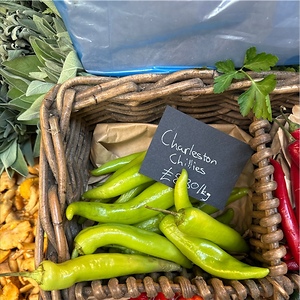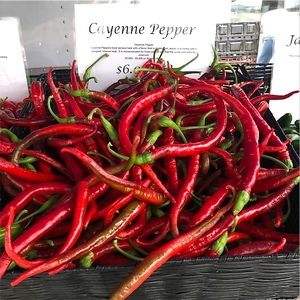


Cayenne Hot Chile Peppers
Estimated Inventory, lb : 0
Description/Taste
Cayenne Hot chile peppers are long and thin, averaging 10 to 15 centimeters in length, and have a straight to curved, conical shape that tapers into a thick, somewhat rounded point. The skin is smooth and waxy with shallow ridges and ripens from pale green, yellow, orange, to red when mature. Underneath the skin, the thin flesh is crisp, aqueous, and ranges in hues of pale green, orange, or red depending on maturity and variety. The flesh also encases a central cavity filled with thin ribs and many flat and round, cream-colored seeds. Cayenne Hot chile peppers are subtly sweet, earthy, and smoky followed with an immediate pungent, hot spice that dissipates quickly.
Seasons/Availability
Cayenne Hot chile peppers are available in the summer.
Current Facts
Cayenne Hot chile peppers, botanically classified as Capsicum annuum, are thin, elongated pods that are members of the Solanaceae or nightshade family. Developed to be a much hotter variety of cayenne pepper, the name Cayenne Hot chile pepper is a general descriptor used for multiple varieties of peppers including the Charleston Hot pepper and Carolina cayenne. These peppers range from 70,000-125,000 SHU on the Scoville scale and widely vary in heat depending on the variety and climate the pepper is grown in. Cayenne Hot chile peppers were developed to maintain the signature, sweet and smoky cayenne flavor while intensifying the spice for use in hot sauces and salsas.
Nutritional Value
Cayenne Hot chile peppers are a good source of vitamins A, C, E and K, manganese, iron, copper, folate, and potassium. The peppers are also a source of capsaicin, which has anti-inflammatory properties and contains beta-carotene and the phytonutrient lutein-zeaxanthin, which provides antioxidant benefits.
Applications
Cayenne Hot chile peppers are best suited for both raw or cooked applications such as sautéing, baking, or roasting. The peppers can be used fresh in salsas, hot sauces, and marinades, or they can be sliced thinly onto salads, pizzas, or sandwiches. The peppers can also be preserved in oil or vinegar for extended use. In cooked applications, Cayenne Hot chile peppers can be mixed with other vegetables and meats in stir-fries, stirred into casseroles, sprinkled over tacos, roasted whole, or added to soups, stews, and curries. The peppers can also be dried and ground into flakes or powder for use as a spice on grilled meats, fish, chilis, and potatoes. Cayenne Hot chile peppers pair well with tomatoes, onions, garlic, ginger, cabbage, corn, avocado, broccoli, bell pepper, beans, and meats such as beef, pork, poultry, and seafood. Fresh peppers will keep 1-2 weeks when loosely stored in whole and unwashed in a paper or plastic bag in the refrigerator.
Ethnic/Cultural Info
Cayenne Hot chile peppers were developed for an intense, spicy heat, but they were also bred to be resistant to root-knot nematode, which is a problematic pest that can destroy large crops of peppers. Through multiple years of research and development within the USDA in South Carolina, varieties such as the Carolina Cayenne and Charleston Hot chile peppers are being created to help commercial farming yield more peppers without compromising cultivation tactics. These peppers have been shown to also help prevent future root-knot nematode in fields and are planted as a rotation crop. The Charleston Hot was so popular when it was released that the USDA filled more than twenty-four thousand requests for seeds in the first four months.
Geography/History
Cayenne Hot chile peppers were developed by the United States Department of Agriculture, or USDA, in South Carolina and were originally bred for commercial farmers in efforts to create a root-knot nematode-resistant cayenne plant. The Carolina cayenne was developed in 1985, and the Charleston Hot was released at the beginning of 1993. Today Cayenne Hot chile peppers are found through small farms, local markets, and specialty grocers in the United States.
Recipe Ideas
Recipes that include Cayenne Hot Chile Peppers. One
| Langsung Enak |
|
Kecombrang Flower Samble Smoked Fish |
| Low Carb Africa |
|
African Okra Soup |










